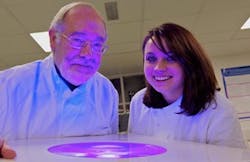Glasgow, Scotland--A lighting system that can kill hospital "superbugs"—including MRSA and C. diff—has been developed by researchers at the University of Strathclyde.1 The technology decontaminates the air and exposed surfaces by bathing them in a narrow band of visible-light wavelengths centered on 405 nm, known as high-intensity narrow-spectrum (HINS) light.
Clinical trials at Glasgow Royal Infirmary have shown that the HINS-light environmental decontamination system (EDS) provides significantly greater reductions of bacterial pathogens in the hospital environment than can be achieved by cleaning and disinfection alone, providing a huge step forward in hospitals' ability to prevent the spread of infection.
This novel decontamination technology was discovered and developed by Scott MacGregor (an electrical engineer), John Anderson and Michelle Maclean (microbiologists), and Gerry Woolsey (an optical physicist).
86% reduction in surface bacterial levels
The clinical trials were carried out in a hospital isolation room used to treat burn patients. Bacteria on environmental surfaces within the room were sampled before, during, and after HINS-light EDS treatment. When the room was occupied by an MRSA-infected burn patient, reductions in surface bacterial levels between 56% and 86% were achieved, with the highest reduction (86%) seen after an extended period of room irradiation by HINS light.
"The technology kills pathogens but is harmless to patients and staff, which means for the first time, hospitals can continuously disinfect wards and isolation rooms," said Anderson. "The system works by using a narrow spectrum of visible-light wavelengths to excite molecules contained within bacteria. This in turn produces highly reactive chemical species that are lethal to bacteria such as meticillin-resistant Staphylococcus aureus, or MRSA, and Clostridium difficile, known as C. diff."
While the HINS light itself is narrowband, the researchers have used a combination of LED technologies to produce a warm-white lighting system that can be used alongside normal hospital lighting.
"Decontamination methods involving gas sterilants or UV light can be hazardous to staff and patients, while cleaning, disinfection and hand washing, although essential routine procedures, have limited effectiveness and problems with compliance," said Scott MacGregor, dean of the faculty of engineering. "HINS light is a safe treatment that can be easily automated to provide continuous disinfection of wards and other areas of the clinical environment. The pervasive nature of light permits the treatment of air and all visible surfaces, regardless of accessibility, either through direct or reflected exposure to HINS-light within the treated environment."
The technology was developed in Strathclyde's Robertson Trust Laboratory for Electronic Sterilisation Technologies (ROLEST), which is dedicated to controlling infection in today's healthcare environments. The research is supported by the University of Strathclyde, The Robertson Trust, and the Scottish Enterprise Proof of Concept Programme, which supports the pre-commercialization of leading-edge technologies emerging from Scotland.
REFERENCE:
1. M. Maclean et al., The Journal of Hospital Infection, Vol. 76, Issue 3, p. 247 (November 2010).

John Wallace | Senior Technical Editor (1998-2022)
John Wallace was with Laser Focus World for nearly 25 years, retiring in late June 2022. He obtained a bachelor's degree in mechanical engineering and physics at Rutgers University and a master's in optical engineering at the University of Rochester. Before becoming an editor, John worked as an engineer at RCA, Exxon, Eastman Kodak, and GCA Corporation.
